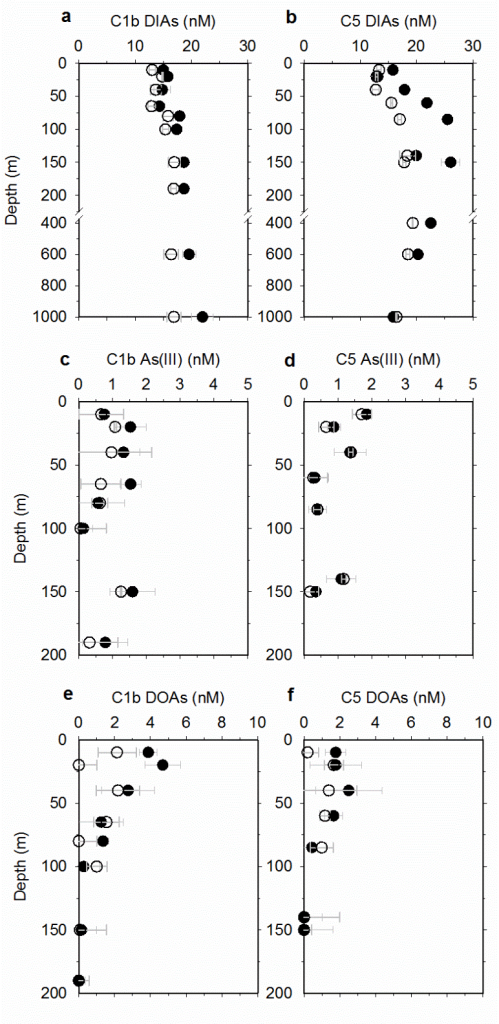Characterization of dissolved arsenics in the South China Sea
Arsenic (As) is an extremely toxic element. But, this element has chemical similarity to that of Phosphorus, which P is an essential nutrient for all organisms. Indeed, arsenic in the ocean can be absorbed by microbes and then transferred to higher trophic levels within marine food chains. The absorbed arsenics then converted into different species, such as arsenate, arsenite, and various organic arsenics, due to detoxification processes. These arsenic species may have different reactivity in the ocean, resulting in a much more complicate biogeochemical cycle than previous believed. Besides to the chemical speciation, size or molecular weight distributions is another factor that may influence the marine biogeochemical cycles. Mounting evidence has shown that marine colloids may be more labile than the low-molecular-weight materials. However, it remains unclear for the importance of colloids for arsenic in marine waters. Thus, in 2014, a research project was initiated, led by professor Liang-Saw Wen and his PhD student Chih-Ping Lee, to characterize the arsenic species in Western Philippine Sea (WPS) and the South China Sea (SCS). Their researchers used combined methods of size fractionation and chemical reactivity to understand the marine biogeochemical cycle of arsenic.
In their first report published in Limnology & Oceanography (Lee et al., 2017, doi: 10.1002/lno.10560), fast turnover rate and diurnal variations were found for the HMW arsenic in WPS eutrophic zone for the first time in the world. In this follow up study, they found less than 20% of the DIAs was in the colloidal fraction (size between 1 kDa and 0.45 μm). Arsenite [As(III)], a metabolite of microbial detoxification, was mostly only found in the euphotic zone, and less than 19% of As(III) was in the colloidal fraction, indicating that arsenate [As(V)] was the predominant inorganic arsenic species in the colloids of the water column. Dissolved organic arsenic (DOAs) was only detected in the euphotic zone, with an average concentration of 3.2 nM. Colloidal organic arsenic accounted for approximately 55% of the DOAs in the surface 100 m. The occurrence of high quantity of DOAs indicated the fast response processes of detoxification and biotransformation by organisms. Overall, this research highlights the important role of marine colloids, which significant influence the cycling of various arsenic species in the ocean.
References:
Lee, C.-P. and Wen, L.-S. (2019) Physical and chemical characterization of dissolved arsenic in the South China Sea. Mar. Chem., 209:128-138, doi: 10.1016/j.marchem.2019.02.001
Lee, C.-P., Cheng, C.-Y., and Wen, L.-S. (2017) Vertical distribution and diurnal variations of high-molecular-weight dissolved arsenic in the oligotrophic ocean. Limnol. Oceanogr., doi: 10.1002/lno.10560.
Figure 1. Depth profiles of dissolved (< 0.45 μm, filled dots) and low-molecular-weight (< 1 kDa, blank dots) arsenic species in two selected stations (C1b and C5) of the South China Sea. (a, b): Dissolved inorganic arsenic (DIAs), (c, d): arsenite [As(III)], (e, f): dissolved organic arsenic (DOAs).











